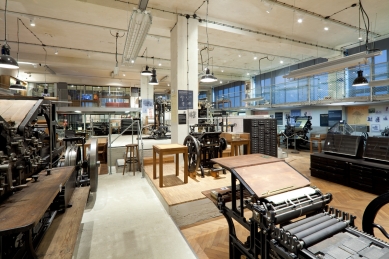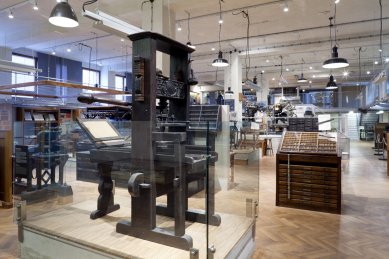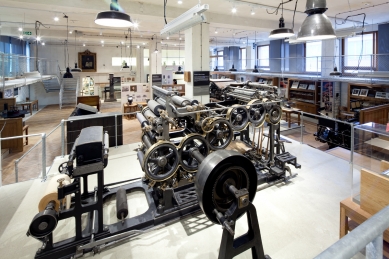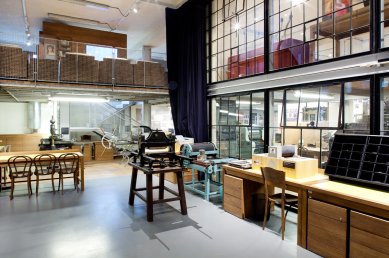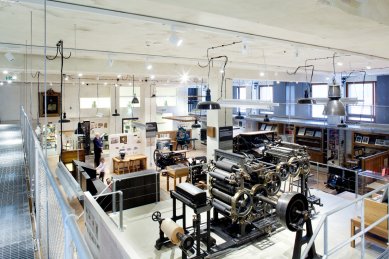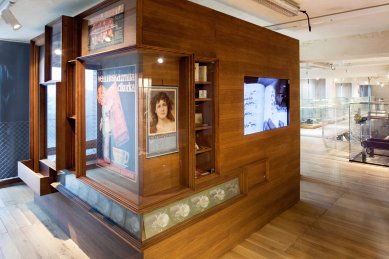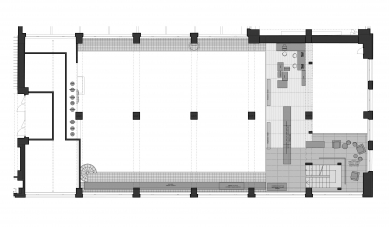
Exhibition of printing at the National Technical Museum

The exhibition design creates an image of the print shop as it looked at the turn of the 19th and 20th centuries. I consider this period appropriate because it is still possible to clearly observe printing as a process in all its breadth of techniques, rather than just as a “magical box” into which a blank page goes and a printed sheet comes out, as is the case today. The environment of the print shop thus creates a natural setting for the machines, enhancing the feeling from most of the authentic exhibits. The fundamental artistic vision of the exhibition is the feeling of a real functioning printing workshop with all its attributes, such as overall dimness with brightly lit details of machines and work surfaces under industrial lighting, clutter on tables and the floor, the smell of inks, sounds, people, and the overall wear of the space due to its use. The credibility of the feeling from the old workshop is also achieved by using typical materials and patinas, textures, and details, such as a worn rough wooden floor, chipped concrete blocks under the machines, a whitewashed brick wall, electrical installations on the walls, cast iron heating, industrial lights... We create a characteristic “printing” hall space, with an inserted mezzanine, pillars, massive beams, and other attributes of an industrial hall space. The entire workshop in exhibition mode is enveloped in darkness, while the exhibits and exhibition areas (tables) are highlighted with bold spotlights.
The feeling of the old workshop is further underscored by small details, such as a forgotten paint can, stains, remnants of work on the floor, or personal belongings left on tables. On the tables, as if the work were about to continue, smaller exhibits such as letters, matrices, tools, prints, functional models illustrating the principles of printing to visitors, as well as modern design texts and labels for the exhibits in the form of metal types evoking the printing technique to which the exhibit relates, are presented. Tables, supplemented by printing shelves, drawers, shelves, type boxes, etc., filled with exhibits, serve as crucial exhibition spaces without resorting to the classic “display case” exhibition. At first glance, the basic and attractive exhibits that attract the attention of laypersons are presented on the open surfaces of the tables. However, upon deeper interest, each spot offers a further array of stored objects, supplementary texts, models, books, prints, etc., for which the visitor must reach, thus actively beginning to participate in the experience themselves. At the same time, the exhibition easily layers for visitors of different levels of expertise and is engaging, entertaining, and educational for various audiences. The exhibition provides a vivid, albeit necessarily greatly simplified, “experiential” impression for complete laypersons, as well as access to information and unique authentic relics and experiences for experts.
It is essential for the viewer to touch the machines, tools, and materials and work with them. Apart from a few historic machines that can be operated, a collection of small machines, models, and toys has been designed for visitors to try out on their own. Visitors can take home small items they print themselves, as examples of individual principles and methods of printing.
On the other hand, for the second fundamental mode - for workshops and groups, the space is maximally bright, primarily due to the use of natural light from large windows. This creates a very distinct light and emotional contrast compared to the exhibition mode. All the mentioned principles and elements thus come into a completely different context, but otherwise function the same. Furthermore, many machines – exhibits become operational machines. This maintains the previously described feeling of a printing workshop for workshops and groups while also bringing the “print shop” to life for regular visitors, who can see the machines at work. Unfortunately, this has not yet happened.
I consider working with authenticity to be fundamental – clearly contemporary designed elements are inserted into the historic hall with the print shop and original machines – demonstration models of printing principles, tactile and olfactory exhibits, additional simplified experimental machines and toys for visitors, hidden areas for workshops. It was important to balance the feeling of an old print shop while also presenting the exhibition in a contemporary manner.
The feeling of the old workshop is further underscored by small details, such as a forgotten paint can, stains, remnants of work on the floor, or personal belongings left on tables. On the tables, as if the work were about to continue, smaller exhibits such as letters, matrices, tools, prints, functional models illustrating the principles of printing to visitors, as well as modern design texts and labels for the exhibits in the form of metal types evoking the printing technique to which the exhibit relates, are presented. Tables, supplemented by printing shelves, drawers, shelves, type boxes, etc., filled with exhibits, serve as crucial exhibition spaces without resorting to the classic “display case” exhibition. At first glance, the basic and attractive exhibits that attract the attention of laypersons are presented on the open surfaces of the tables. However, upon deeper interest, each spot offers a further array of stored objects, supplementary texts, models, books, prints, etc., for which the visitor must reach, thus actively beginning to participate in the experience themselves. At the same time, the exhibition easily layers for visitors of different levels of expertise and is engaging, entertaining, and educational for various audiences. The exhibition provides a vivid, albeit necessarily greatly simplified, “experiential” impression for complete laypersons, as well as access to information and unique authentic relics and experiences for experts.
It is essential for the viewer to touch the machines, tools, and materials and work with them. Apart from a few historic machines that can be operated, a collection of small machines, models, and toys has been designed for visitors to try out on their own. Visitors can take home small items they print themselves, as examples of individual principles and methods of printing.
On the other hand, for the second fundamental mode - for workshops and groups, the space is maximally bright, primarily due to the use of natural light from large windows. This creates a very distinct light and emotional contrast compared to the exhibition mode. All the mentioned principles and elements thus come into a completely different context, but otherwise function the same. Furthermore, many machines – exhibits become operational machines. This maintains the previously described feeling of a printing workshop for workshops and groups while also bringing the “print shop” to life for regular visitors, who can see the machines at work. Unfortunately, this has not yet happened.
I consider working with authenticity to be fundamental – clearly contemporary designed elements are inserted into the historic hall with the print shop and original machines – demonstration models of printing principles, tactile and olfactory exhibits, additional simplified experimental machines and toys for visitors, hidden areas for workshops. It was important to balance the feeling of an old print shop while also presenting the exhibition in a contemporary manner.
The English translation is powered by AI tool. Switch to Czech to view the original text source.
0 comments
add comment


